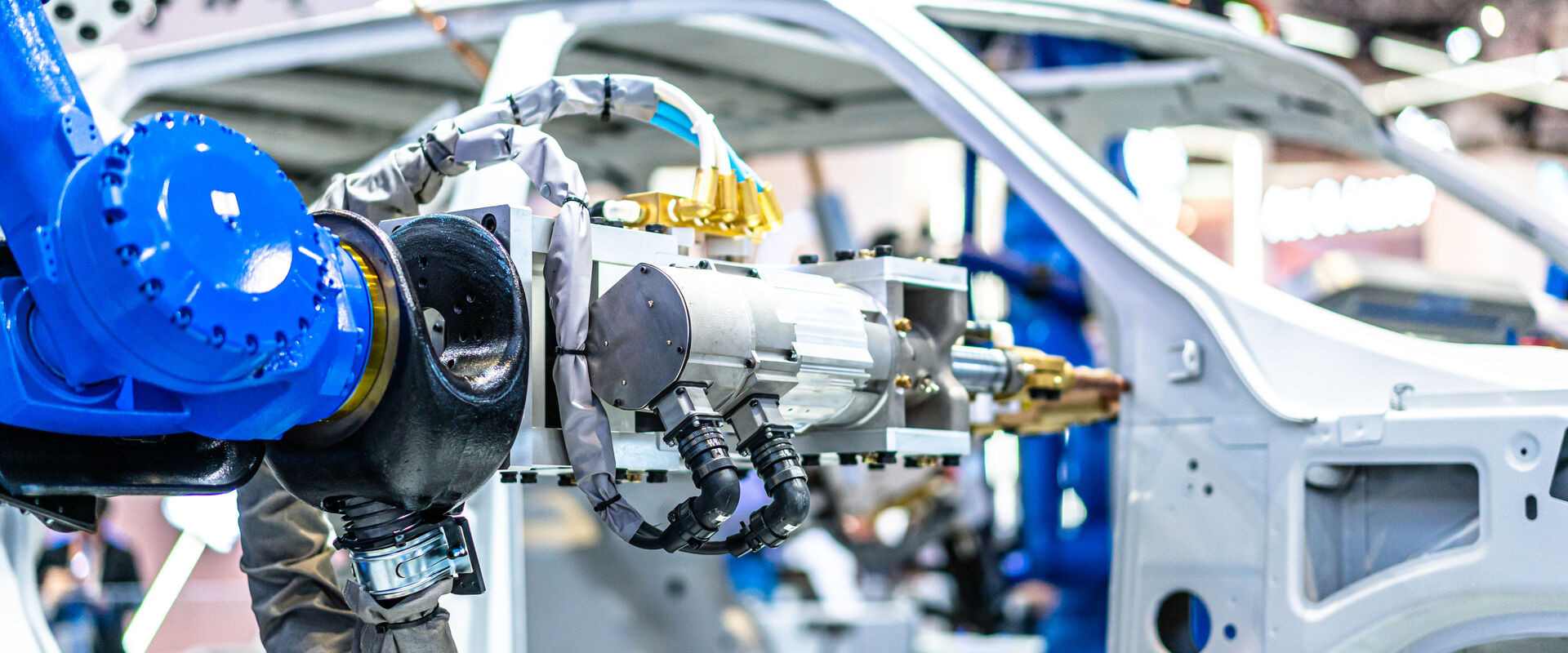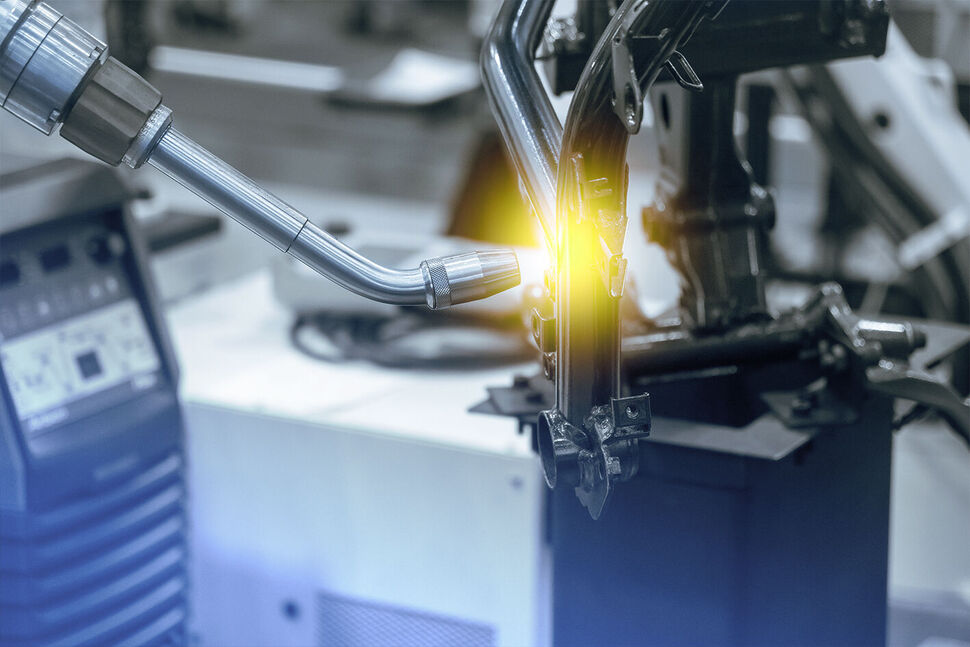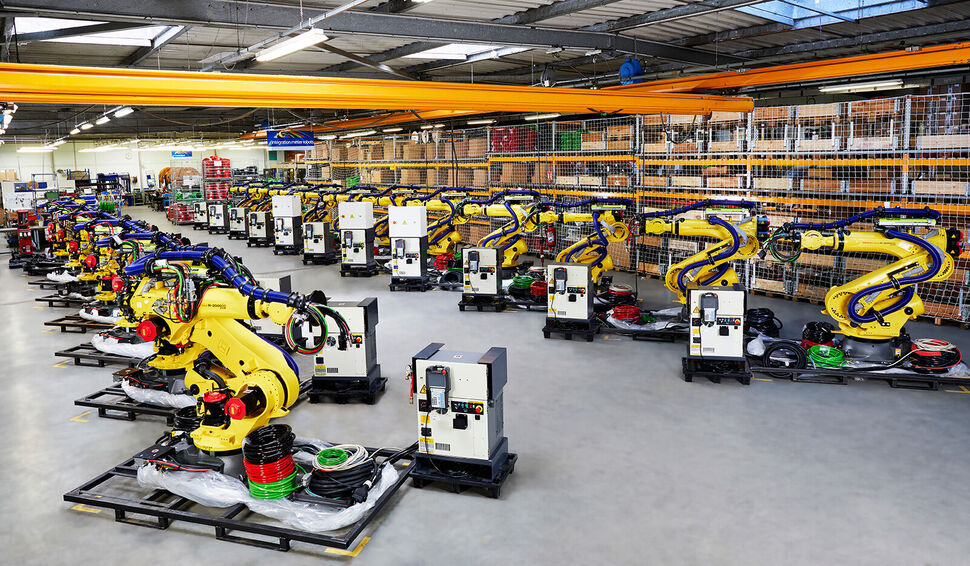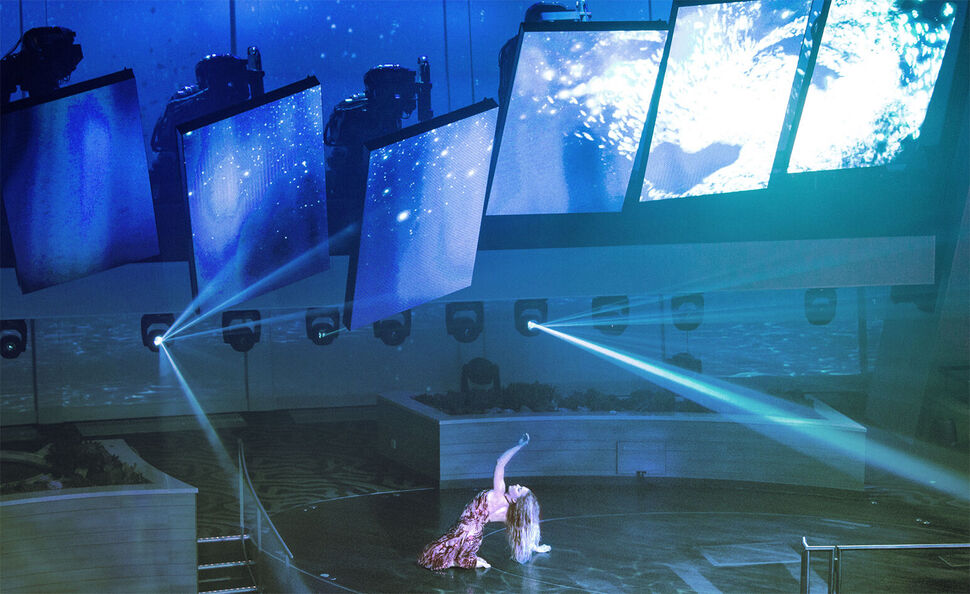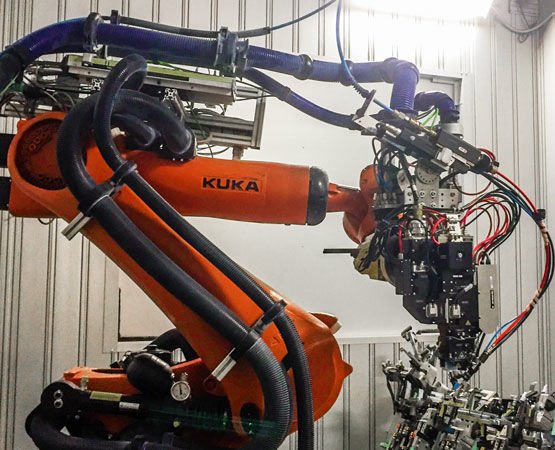Robotics Applications – Reliable Solutions for Dynamic Environments
The robotics market has stood out for many years due to its solid growth and promising future. Across the globe, industrial robots have become an essential part of modern production environments. They provide the foundation for precision, consistent quality, and minimized cycle times. At the same time, seamless interaction between electronics and mechanical components is essential. As such, products developed for robotic applications must meet specific performance requirements, and often face complex technical challenges.
Cabling, hoses, and energy supply systems used on robots must deliver exceptional performance under extreme conditions. They need to withstand rapid acceleration and deceleration, as well as tensile, compressive, and torsional forces across millions of bending cycles. These components must also resist high temperatures, weld spatters, oils, and aggressive chemicals. Above all, the goal is to ensure long-term reliability and maximum uptime of robotic systems, securing productivity and minimizing downtime.
As automation evolves, so do the application demands. Robots are no longer used only in automotive welding lines or material handling. They are now found in a wide variety of industries and processes - from cleanroom manufacturing and high-speed palletizing to collaborative robotics, battery pack assembly, and more. Each application poses unique environmental, mechanical, and integration challenges.
To meet this diversity, BizLink offers a broad range of tailored cable management systems, cables, hoses, and complementary accessories. Our solutions are designed to fit the needs of different industries, robot types, and operating conditions - whether it's ultra-flexible cables for compact robots, protective systems for harsh welding zones, or particle-free components for cleanroom environments. In addition, with careDP, our condition-based monitoring system for robotic dresspacks, we offer a digital solution that enhances uptime and reduces unexpected failures. By continuously monitoring the mechanical behavior of dresspacks in real time, careDP helps detect anomalies early, supports predictive maintenance strategies, and increases transparency in automated production environments.
To complement our physical solutions, BizLink also offers professional training programs that go well beyond our own products. Under the umbrella of Automation Systems Training, we equip technicians, engineers, and production staff with practical and theoretical knowledge covering a wide range of automation-related topics from troubleshooting strategies to system integration know-how.. Our training portfolio includes: Instructor-led training: In-depth, hands-on sessions delivered on-site or at BizLink facilities, tailored to real-world applications. Online training: Flexible, self-paced modules accessible 24/7 via the BizLink Online Training platform, ideal for continuous upskilling across global teams. By combining robust components, smart diagnostics, and continuous learning, BizLink supports the long-term reliability and efficiency of automated systems, helping customers stay competitive in fast-evolving industrial environments.
Boost Performance in Critical Robotic Applications
Whether you're optimizing high-speed production lines or ensuring reliability in demanding environments — our robotic system solutions are built to perform where it matters most. We support a wide range of applications where durability, precision, and seamless integration are essential:
- Handling / Material Handling
- Spot Welding
- Riveting
- Screwing
- Clinching
- Adhesive Bonding / Gluing
- Laser Brazing / Laser Welding / Laser Cutting
- Stud Welding
- Cleanroom Applications
Looking for the right solution for your process? We're here to support you.
Discover our Sales Network to find official BizLink partners worldwide.
BizLink Robotic Solutions Germany GmbH
An der Auehütte 10
98574 Schmalkalden
Germany
BizLink Robotic Solutions France S.A.S.
1 Av. Louis Pasteur, Zone Industrielle de Gellainville
28630 Gellainville
France
BizLink Robotic Solutions USA, Inc.
100 Kay Industrial Drive
48359-1831 Lake Orion, Michigan
United States
BizLink Special Cables (Changzhou) Co., Ltd.
No. 21 Taihu West Road, Xinbei, Changzhou
200051 Jiangsu
China
Arc Welding
The quality and consistency of a welding seam is of major importance.
If the welding result is insufficient the entire production process can come to a halt because defective parts, high reject rates and thus high costs are the consequence.
Arc welding is used for side beams or wheel arches e.g. In this process the TCP of the welding wire can move slightly when it comes to copper wear in the contact pipe of the welding torch. Aside from that, the TCP can also deviate from its origin after cleaning the welding torch.
BizLinks calibration system advintec TCP controls the TCP of the welding wire, also during automated production. The robot program is automatically corrected by the measured variations and ensures that the welding torch always operates in the correct position.
Integration-Ready Robots
The challenge of integration-ready robots lies in the large variety of robots and applications.
For all of these we have to design and supply complete, fully functional, robot function packages. Our customers wish to receive turnkey system solutions.
In this process a significant part of the BizLink product portfolio is involved. We install robot dress packages, tools & weld controllers, dense packs, electrical junction boxes etc. We also take over the configuration, setup and test of tooling, software and Tool Center Point calibration. Moreover we handle the programming and integration into existing production equipment or set up of new systems.
Dresspacks & Cables in Robot-Powered Entertainment
As they look to attract a younger generation of passengers, cruise lines are setting new standards for high-tech, action-packed entertainment that rivals Las Vegas. One leading cruise line is making waves with a colossal robotic screen system equipped with dresspacks and cables from BizLink.
The heart of the ship is a multi-level entertainment space offering a breathtaking 270° panoramic view of the ocean. Gigantic floor-to-ceiling glass walls that span almost three decks at the cruise ship’s stern combine to form a surface that is over 30 meters long and 6 meters high. This surface can be used as a projector screen and turned into a massive viewing area. With a 12K resolution (11,520 x 2,160 pixels), the surface creates a stunning backdrop that can be used by the varied and versatile entertainment program that takes place on the dynamic stage before it.
Center-stage when showtime comes is the robotic screen entertainment system, made possible by the combined efforts of the cruise line, Robotic Arts, ABB Robotics, and BizLink. A gantry system consisting of six ABB IRB 6620 robots — equipped with BizLink dresspacks and cables and tipping the scales at 8.2 metric tons — is used to control the attached user-programmable screens. And since every robot has six axes, there’s plenty to control. What’s more, each robot can also move from left to right and up and down. So there are in fact a total of 48 axes that need to be coordinated and synchronized for each sequence of movement.
What, then, was BizLink’s contribution to this groundbreaking project? For a total of three vessels, BizLink supplied all of the black dresspack systems (axis 1 to 6), the SLS line retract systems, and the robot’s fiber optic and power cables.
Several BizLink companies were involved in the project: BizLink Robotic Solutions USA, as the coordinating company; BizLink Elocab; and BizLink Robotic Solutions Germany, which equipped the six robots with dresspacks locally and delivered them directly to the shipyard. Careful planning was essential, since there was only a small window of time for supplying the machinery before the vessel’s primary deck was closed.
The combination of robots and screens now powers a kind of entertainment never seen before, where the robotic screens themselves become performers, interacting with dancers, acrobats, and vocalists to deliver a high-speed, energy-packed show. With the vessel’s inaugural season now complete, it’s clear that the robotic screen entertainment project has been a complete success. And BizLink is part of this spectacular show on the high seas.
Automotive Laser Welding
In the race to meet fuel economy regulations, the automotive industry is turning to aluminum more frequently because of the material’s lightweight, fuel-efficient properties. Fabricating Full vehicle aluminum body frames often relies on automated laser welding, but one of the many challenges with this process is selecting a cable management system that tolerates the robots’ repetitive motion.
Mercedes-Benz has seven robotic workcells in one of its manufacturing facilities that fabricate aluminum automotive frames using laser welding. The fiber-optic cables that delivered power to the laser head to weld the aluminum together had been experiencing problems withstanding the trajectory of the robot and its very-high-duty-cycle performance. As a result, every three months, technicians had to assess, repair or replace a broken cable.
Laser welding systems are delicate, and when something fails, there’s a tremendous cost in both downtime and components.
To prevent further downtime and reduce component costs, Mercedes-Benz approached BizLink for a solution. The company introduced the automaker to the LSH 3, an umbilical system, or dress pack, of integrated cables and hoses servicing the robot’s end-of-arm tooling.
As part of a one-year test run, BizLink installed a single umbilical application in December 2014 that protected all the umbilicals – air, water, fiber optic laser delivery, etc. – for one robotic workcell. The cable operated until December 2015 without any need for replacement, resulting in 100% uptime and a return on investment within one year.
Based on the success of the test run, Mercedes-Benz wanted to apply the dress pack to the six remaining work cells. To further improve the design, Mercedes engineers asked BizLink to develop a dual LSH 3 umbilical system. The first umbilical provides all the power, communications, cooling water, and air to the robot’s end-of-arm tooling. The second umbilical run the fiber optics separately to ease mean time to repair should the cable go down.
BizLink technicians and Mercedes-Benz robotic cell programmers collaborated to set mechanical parameters directly on the dresspack. Jack explains, “Every LSH 3 is application-driven, designed according to the program variables in place, such as force, weight, speed, and cycles. By working together, we optimized the system.”
After BizLink installed the dual umbilical system on the first robot, the Mercedes-Benz team successfully mounted the dresspacks on the remaining six robotic cells. Jack states that the project became “a true win-win situation, operating for over a year without a single component replacement or downtime event.”
BizLink technicians and the Mercedes-Benz robotic workcell programmers collaborated to set mechanical parameters on the dress pack itself. “Every LSH 3 is application-driven based on the type of program variables that are in place, such as force, weight, speed and cycles,” Jack says. “We optimized the system by working together.”
Once BizLink set up the first robot with the dual umbilical system, the Mercedes-Benz team successfully installed the dress packs on the six other robotic workcells. The project resulted in a “win-win situation that lasts a year or better with no single component replacement or downtime event,” Jack says.
